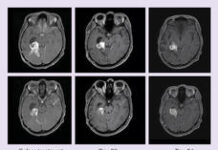, by NCI Staff
People with cancer nearing the end of their life are not getting needed opioids to control their pain, a new study indicates.
In the study, researchers found that the proportion of people with cancer who filled a prescription for opioid drugs within the last month of their life dropped between 2007 and 2017. And over that same period, the number of emergency department visits for pain among people with cancer in the last month of life increased dramatically. The findings were published July 22 in the Journal of Clinical Oncology.
Although the new study could not directly link the decrease in opioid prescriptions to the increase in emergency department visits, “I do think these visits are sort of a canary in the coal mine,” said Andrea Enzinger, M.D., of the Dana-Farber Cancer Institute, who led the research team. “We really don’t know the full extent to which patients are suffering, but I think it’s likely a good bit more than what we’ve reported.”
Beginning in the 2010s, many US states began enacting regulations to curb inappropriate opioid prescribing amid a growing epidemic of opioid overdose deaths. An unintended consequence of these regulations is that it became much harder for people with cancer to access pain medications, even at the end of life.
“This study demonstrates that, at a time in the US when the primary dialogue about opioids was abuse, cancer patients who need opioids for pain management were not getting them,” said Lori Minasian, M.D., of NCI’s Division of Cancer Prevention (DCP), who was not involved in the research.
“The regulations that have been implemented to try to counteract the [opioid epidemic] have made things harder for our cancer patients,” added Judith Paice, Ph.D., R.N., director of the Cancer Pain Program at Northwestern University’s Feinberg School of Medicine, who also was not involved in the study. “There definitely needs to be advocacy work related to [opioid access] for people with a cancer diagnosis.”
Unintended Consequences
The conversation around the use of opioids to relieve cancer-related pain is a complex one, explained Dr. Paice.
“The amazing thing about oncology right now is that we’ve got extraordinary treatments that are leading to long-term survival [for many patients],” she said. But pain is often part of the cancer experience, she continued. Some people may experience pain during treatment, while others may live with pain long after treatment has stopped.
In both situations “opioids should be used with caution, because of people’s [potentially] very long lifespan and fears of long-term complications of opioids,” Dr. Paice said. “But all of the guidelines agree that opioids are the mainstay of cancer-related pain management for people with advanced disease.”
Although studies have looked at opioid use among people with cancer, it hasn’t been clear how opioid regulations have affected those who are dying from their disease, for whom pain can often be severe. So Dr. Enzinger and her colleagues decided to track trends in opioid prescriptions for people with cancer near the end of life.
To do so, they looked at data from a random sample of 20% of Medicare beneficiaries over the age of 65 with poor-prognosis cancers who had died between 2007 and 2017. They chose this period because it covered the years when the extent of the opioid crisis was widely recognized, legislative reforms were first enacted, and prescriptions for opioids began to decline.
The team recorded all outpatient opioid prescriptions filled within 30 days of death or enrollment in hospice for about 270,000 people. They further broke the prescriptions down by long-acting opioids, such as extended-release morphine or fentanyl patches, and short-acting opioids, such as codeine or oxycodone.
They also looked at the doses of medications prescribed. Finally, they looked at trends in emergency department visits among the same population, both for pain and other reasons.
During the decade studied, the proportion of cancer patients near the end of life who filled one or more opioid prescriptions declined from 42% to about 35%. The proportion who received long-acting opioids, which are most effective for treating severe cancer-related pain, declined from 18% to about 11%.
The latter finding is “discouraging,” said Dr. Paice, “because long-acting opioids are crucial to allow people to have pain-free periods or significant reductions in pain.”
For those who did fill prescriptions for opioids, their mean daily dose of medication dropped by about 25%.
Over the same decade, the proportion of patients with cancer who went to the emergency department for pain in their last month of life increased by nearly 51%, from about 13% to almost 20%. Visits for nausea and vomiting, by contrast, did not increase during the same time period.
Substantial Barriers to Pain Relief
Even people with advanced cancer now face substantial barriers to receiving opioids, “and they’re multilayered,” Dr. Enzinger explained. They start with oncologists.
Over the last decade, she’s seen providers become less comfortable with prescribing opioids to people with cancer pain, often turning first to less-stigmatized but also less-effective pain medications. “There’s so much messaging around safe opioid prescribing, I think it very well may be subconsciously changing the way we approach treating patients’ pain,” said Dr. Enzinger.
Institutions may also require that doctors sign a written opioid agreement with patients, and nearly all states now require doctors to check an online database of opioid prescriptions, called a prescription drug monitoring portal, before writing the prescription. With the average clinic visit allowing only about 15 to 30 minutes to discuss issues ranging from treatments to end-of-life concerns, these added hurdles “make it even harder [to write an opioid prescription],” added Dr. Enzinger.
Even greater barriers come from the broader health care system, especially insurance coverage restrictions, Dr. Paice said. “We may write a prescription for a patient, but the insurance company will not pay for that prescription without something called a prior authorization,” she explained. Under a prior authorization, an insurance company must give permission for the prescription before it can be filled.
Such paperwork is so involved that cancer clinics must hire additional people just to process the documentation, Dr. Paice explained. And it’s not a one-time thing. Authorizations may only last a few months, or even a few weeks, she said, requiring the same process to be completed over and over again.
Other barriers include pharmacies limiting the number and types of opioids they carry, prescriptions that can’t be transferred between pharmacies, and unaffordable co-pays, Dr. Paice added. All these obstacles have persisted since 2017, and in some cases, “appear to have worsened,” said Dr. Paice.
The study only looked at prescription patterns in older adults. Although people over the age of 65 account for most deaths from cancer, younger people can also face terminal disease. Younger people also encounter issues of access to pain medication, and the situation may be even worse for them, Dr. Enzinger said.
“This is also a health disparities issue, because cancer patients from racial or ethnic minority groups are already significantly less likely to be prescribed opioids at the end of life,” added Alexis Bakos, Ph.D., M.P.H., a program director in DCP.
Finding Comfort at the End of Life
On top of all the other barriers, patients often feel uncomfortable when offered an opioid painkiller, even at the end of life, added Dr. Enzinger.
“We hear people with very advanced disease say, ‘I’m terrified of becoming addicted.’ But that’s such a rare problem in this population, it really shouldn’t be weighing into the decisions about pain management,” she said.
The risk of overdose among cancer patients at end of life is also rare, explained Dr. Paice, but still frightens people. “I’ve seen [this fear] very strongly with fentanyl,” she said. “But prescribing a fentanyl patch to somebody who has advanced cancer is not going to lead to overdose.”
In her practice, Dr. Paice continued, they spend a lot of time educating patients near the end of life about how opioids can help improve their quality of life. “Opioids can … allow them to move, allow them to be comfortable, allow them to do the work that needs to be done in their final days, weeks, or months of life, because their pain has been relieved.
“As a community, oncologists understand there’s an opioid epidemic. We understand that you need to train physicians in the appropriate use of opioids,” she said. “But this paper shows us that the policies put in place to reduce the inappropriate use of opioids is also reducing the appropriate use. We need more research to address ways to reduce opioid abuse and yet still permit patients to get opioids for pain relief at the end of life.”
These questions don’t just apply to people with cancer, she added. “There are other diseases for which, at the end of life, you should be able to have pain medication,” Dr. Minasian said.
The field may eventually be aided by efforts like the NIH HEAL Initiative, which is funding research on nonopioid therapies for pain management. For now, explained Dr. Enzinger, any person with cancer who is experiencing pain—at any point after their diagnosis —would likely benefit from a referral to a palliative care specialist.
“An awful lot of cancer patients never get to talk to a palliative care expert,” Dr. Minasian said. “But it’s been demonstrated over and over again that if you provide good supportive care, including pain management, people will actually live longer.”










